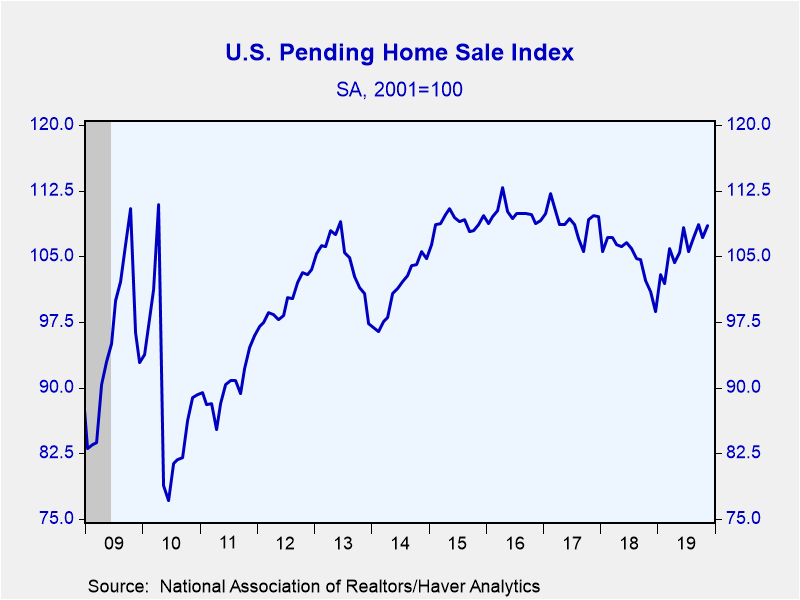 Global| Dec 30 2019
Global| Dec 30 2019U.S. Pending Home Sales Rebound in November
Summary
U.S. pending home sales rose 1.2% (+7.4% y/y) in November, according to the National Association of Realtors (NAR) after falling 1.3% in October. October was revised from a 1.7% drop. The November index level of sales was 108.5 [...]
U.S. pending home sales rose 1.2% (+7.4% y/y) in November, according to the National Association of Realtors (NAR) after falling 1.3% in October. October was revised from a 1.7% drop. The November index level of sales was 108.5 (2001=100).
Sales were modestly mixed around the country during November. They gained in the Midwest and the West while they eased in the Northeast and the South. The West was the strongest, up 5.5% (+14.0% y/y), turning around from a 1.9% decline in October. In the Midwest, sales rose 1.0% (+5.0% y/y) after decreasing 2.6% in October. The November decreases in the Northeast and the South were quite small, actually, 0.1% in the Northeast (+2.6% y/y) after rising 2.7% the month before, and 0.2% in the South (+7.7% y/y), following a decline of 1.7% the prior month, which was unrevised.
With this latest report, it can be seen that all four regions recovered from a weak period in late-2018 and early-2019, but have been fairly range-bound across the rest of this year.
The pending home sales index measures sales at the time the contract for the sale of an existing home is signed, analogous to the Census Bureau's new home sales data. In contrast, the National Association of Realtors' existing home sales data are recorded when the sale is closed, which is a month or two later. Accordingly, in developing the pending home sales index, the NAR found that the level of monthly sales contract activity precedes the level of closed existing home sales by one to two months. The series dates back to 2001, and the data are available in Haver's PREALTOR database. Mortgage interest rates from the Mortgage Bankers Association can be found in the SURVEYW database and from the Wall Street Journal compilation in USECON.
| Pending Home Sales (SA, 2001=100) | Nov | Oct | Sep | Nov Y/Y % | 2018 | 2017 | 2016 |
|---|---|---|---|---|---|---|---|
| Total | 108.5 | 107.2 | 108.6 | 7.4 | 104.7 | 109.1 | 109.8 |
| Northeast | 96.3 | 96.4 | 93.9 | 2.6 | 92.4 | 97.1 | 96.4 |
| Midwest | 102.5 | 101.5 | 104.2 | 5.0 | 100.2 | 104.9 | 107.4 |
| South | 125.0 | 125.3 | 127.5 | 7.7 | 121.6 | 123.9 | 123.0 |
| West | 98.4 | 93.3 | 95.1 | 14.0 | 92.3 | 99.5 | 102.3 |
Carol Stone, CBE
AuthorMore in Author Profile »Carol Stone, CBE came to Haver Analytics in 2003 following more than 35 years as a financial market economist at major Wall Street financial institutions, most especially Merrill Lynch and Nomura Securities. She has broad experience in analysis and forecasting of flow-of-funds accounts, the federal budget and Federal Reserve operations. At Nomura Securites, among other duties, she developed various indicator forecasting tools and edited a daily global publication produced in London and New York for readers in Tokyo. At Haver Analytics, Carol is a member of the Research Department, aiding database managers with research and documentation efforts, as well as posting commentary on select economic reports. In addition, she conducts Ways-of-the-World, a blog on economic issues for an Episcopal-Church-affiliated website, The Geranium Farm. During her career, Carol served as an officer of the Money Marketeers and the Downtown Economists Club. She has a PhD from NYU's Stern School of Business. She lives in Brooklyn, New York, and has a weekend home on Long Island.







